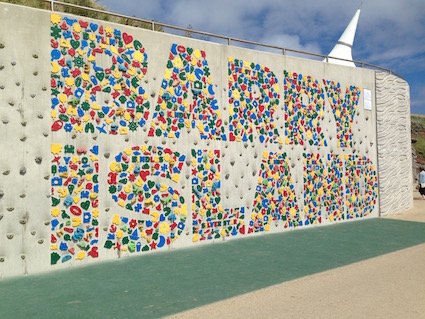
In the Welsh seaside town of Barry, a place made world famous by the Gavin and Stacey sitcom, lies a typographic traversing wall. It was designed by Gordon Young in association with Part Two – a London-based design consultancy and opened in 2014.
Whilst this public artwork may seem far removed from the cheaper and less showy designs in school playgrounds, the approach used to create the wall is very relevant and applicable for any school considering installing one in their grounds. It is better to view such a feature as a longer-term educational project rather than a quick-fix, grab ‘n’ go design from a playground catalogue.
Also do not feel disheartened if your school’s traversing wall is looking somewhat abandoned. Very often, like trim trails, they can rapidly fall out of use. If this is the situation, then read on for some ideas to help children rethink their purpose and re-focus their attention.
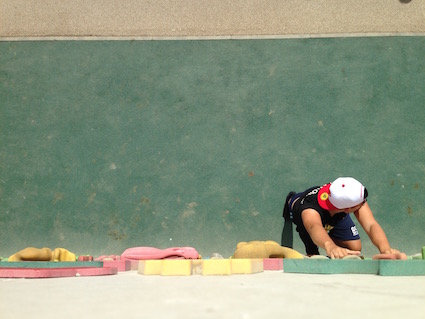
1.Collaborate with other professionals
Gordon is a collaborative artist. He brings in other professionals to advise and work with him on projects. Very often it is the cross-pollination of ideas that results in creative developments. The local history group helped with the history of the promenade and cultural associations of Barry Island. The explosion of bright colourful recycled designs reflect the Toy Factory – a big toy shop that previously stood on the site selling buckets and spades. Each of the words hidden in the wall’s design are of significance to the community. For example, the The Strollers were a local dance band.
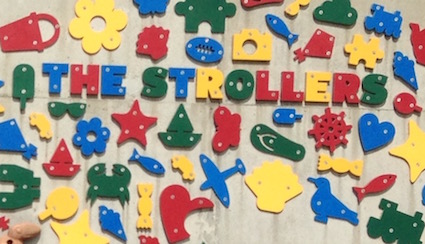
Many playground equipment and climbing wall companies are happy to help collaborate to produce a bespoke wall which has meaning to the children and local community who use it. It may cost more but it is worth it, in terms of social value.
For those that already have a traversing wall, consider the backdrop and whether a mural can help provide a cultural connection where the holds are a natural part of the mural design.
2. Involve a professional climber in the design
Climbers see walls in different ways – for their feel, shape, material, climb-ability and so on. Local climber, Rob Larney was part of the consultation team. As a result the wall has hidden challenges making it interesting and accessible not just for children but for a range of abilities including professional climbers. The grey holds invite more able climbers to traverse the wall, but the huge standalone letters appeal to children’s need to climb upwards. The traditional resin holds are cleverly blended into the recycled plastic shapes. These are fun as well as functional.
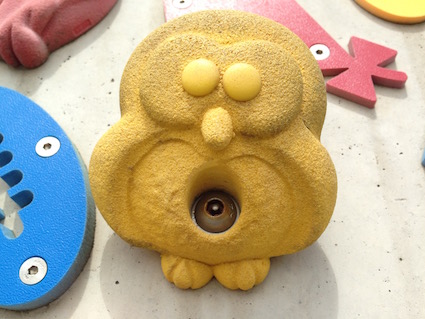
Sometimes a climbing wall is viewed by children for different purposes. I’ve seen them used for hanging up resources and creating dens. Who says climbing walls must always be for climbing?
3. Give children experiences to make informed decisions and choices
Climbers can also enthuse children. They may bring their climbing equipment to school and show children the purpose of the kit and photos of it in use. This could be integrated into a visit to a local climbing wall where children are taught the basics of rock climbing. This can be followed up with rock climbing on real rock led by your local approved provider. By enabling children to make connections between the design of a traversing wall and how this can be used to develop the skills and physical co-ordination, fitness and strength required to be a climber, then the climbing wall being designed suddenly has greater purpose and meaning to the children.
If you already have a traversing wall in place, then inviting a climbing to re-invigorate interest and use of the wall can be a valuable learning opportunity too as well as a chance to look at ways of integrating rock climbing into your PE provision. There are lots of games which can be played on walls to improve climbing and other physical and social skills. This website has the best collection I’ve found.

4. Design for how children will use the wall not what adults or playground equipment companies want or desire them to do
Children, in the main, are seekers of height so tend to be drawn to this rather than horizontal climbing challenges. I witnessed similar behaviour at Barry Island. Every single child who stopped and climbed chose to climb up rather than along. That’s where the challenge lies. That’s where each and every one of us quietly push ourselves to the limits of our height threshold. The Barry Island wall acknowledges this innate desire within all of us.
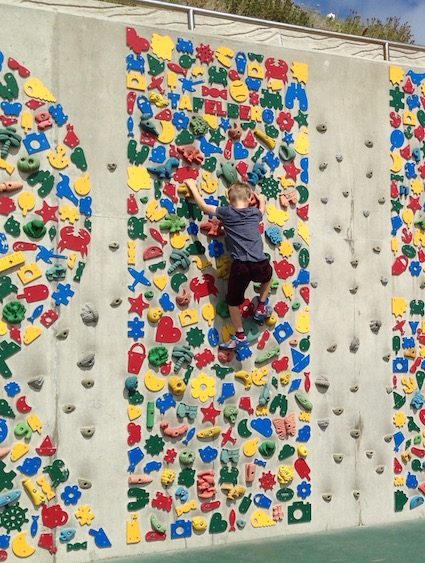
So it is a sensible precaution to take time to explore what the possibilities are. Observe how children are playing with other features in your playground and what they like to do. Go and visit other schools’ traversing walls and see how children are using them. It may be that resin boulders rather than a traversing wall is what your children will find better suited to their climbing needs. Alternatively, climbing holds can be added to other features not just walls.
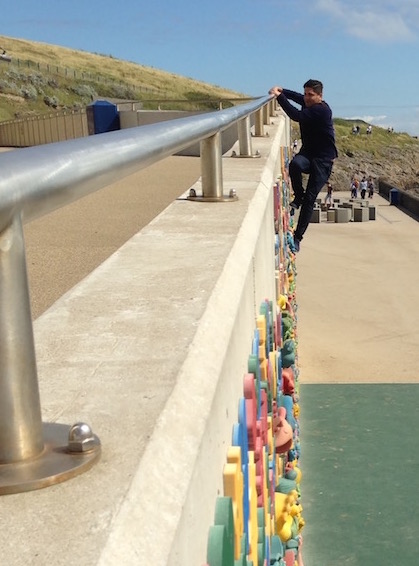
5. Incorporate safety measures that help rather than hinder play
If you look at the person in the above photo he’s made it to the top of the climbing wall. The metal barrier is accessible for those who reach this climax and assists them to climb over and off the wall. It’s a really helpful safety measure – and perhaps a concept that needs more thought within the design of climbing walls for schools. What safety measures help rather than hinder play?
If you look below the Barry Island wall, there is a fall surface – but as you can see from the photos, the height at which children can climb up is a good height – so make the most of every centimetre of permitted height in relation to the type of safety surface that is put below. Children will only go as high as they feel comfortable.
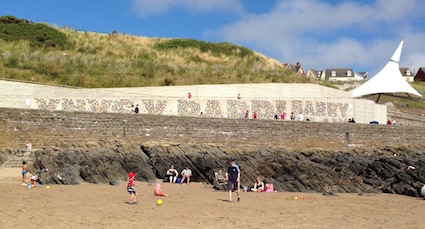
6. Consider the aesthetics of the climbing wall
One of the remarkable aspects of the Barry Island wall is how it stands out from, yet at the same time blends into the landscape. The bright colourful holds disappear at a distance on the 40-metre long wall with its large letters in Welsh and English. Curiously, if you are landing at the nearby Cardiff airport, you will get a great view of the wall because of it’s design which can be easily seen from above. It’s hard to believe that there are over 4000 seaside shapes in 30 different designs and 1000 novelty climbing holds.
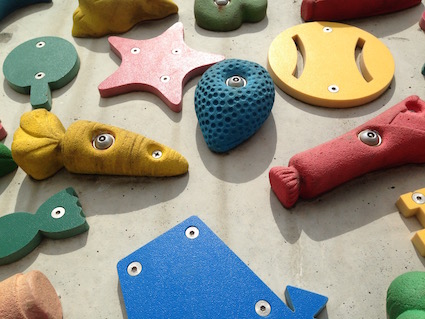
7. Think about the environmental impact of your wall
Generally climbing walls are tough and will withstand many years of hard use if properly installed and maintained. However, looking at how to minimise the environmental impact of installing a design can help children understand that this is a matter which always requires consideration.
The seaside shapes were designed by Gordon with the help of local school children during a series of workshops. The shapes were cut from sheets of recycled plastic with the same machine that was used for the Comedy Carpet. They have proved to be affordable, colourful and can withstand the saltwater spray. It is a thought-provoking link when we consider the amount of marine pollution caused by plastics.
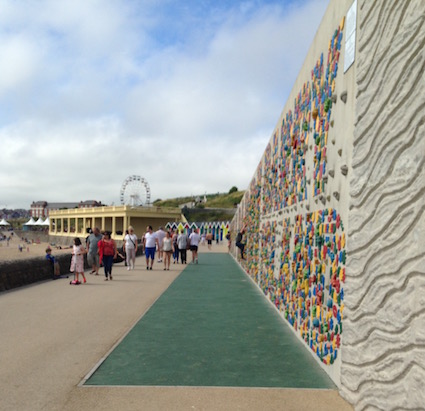
Finally, I would like to finish by acknowledging Gordon Young’s creativity. He is consistently creating public art work that people can physically interact with. He makes words come alive in a physical sense beyond the cognitive processing – making us rethink the beauty of words and the design possibilities around the imaginative use of text. In this work, he has also made climbing accessible to passers-by and not just to those who dare enter a traditional indoor climbing arena. Now that rocks!
This blog post was originally published in July 2016.






























This makes me want to visit Barry with the kids. A positive and thoughtful analysis Juliet.
Thanks Steve
I was really impressed with the whole beach and esplanade – really clean, no litter and felt well managed. The beach huts have been beautifully done up and the climbing wall is well worth a visit.